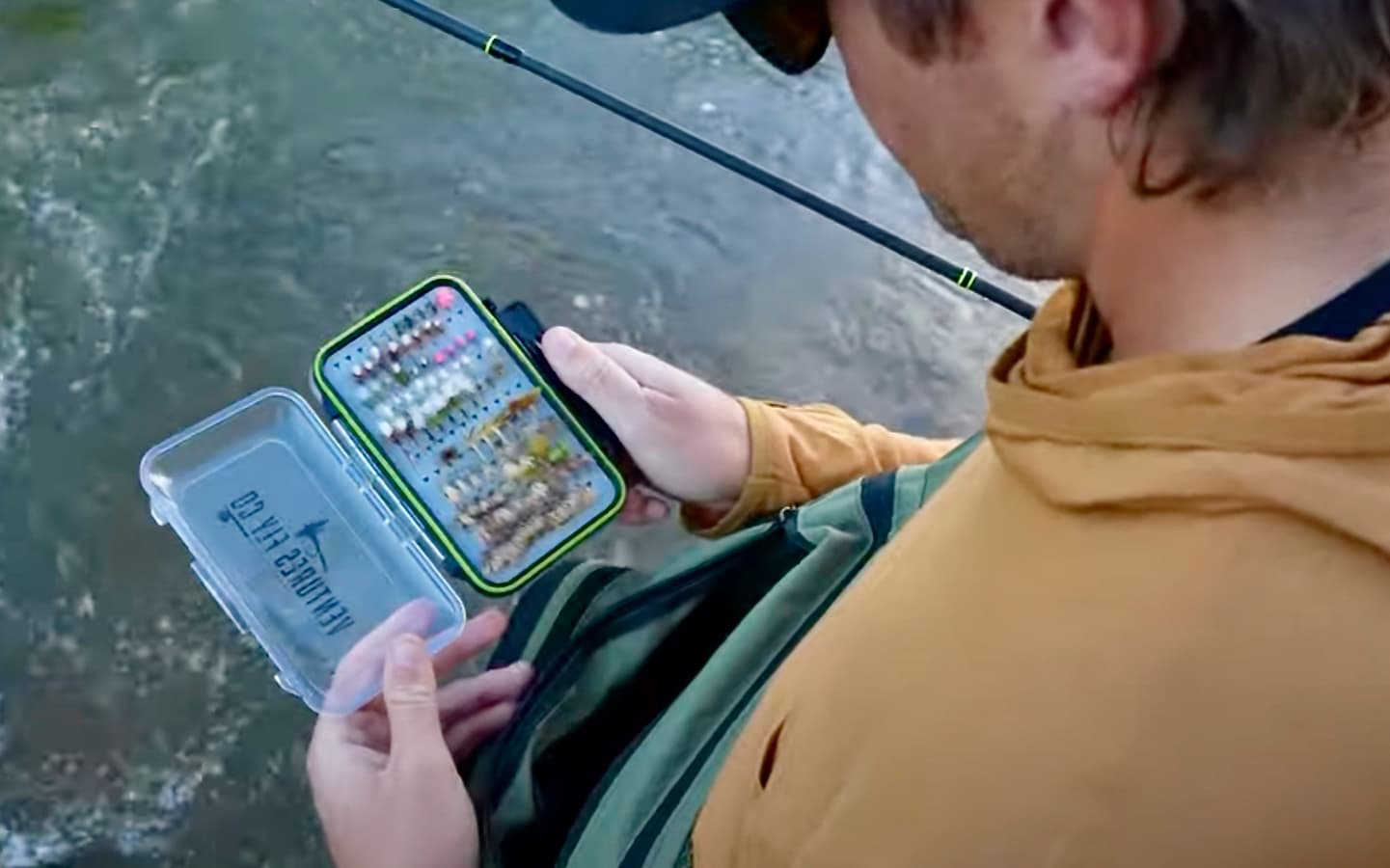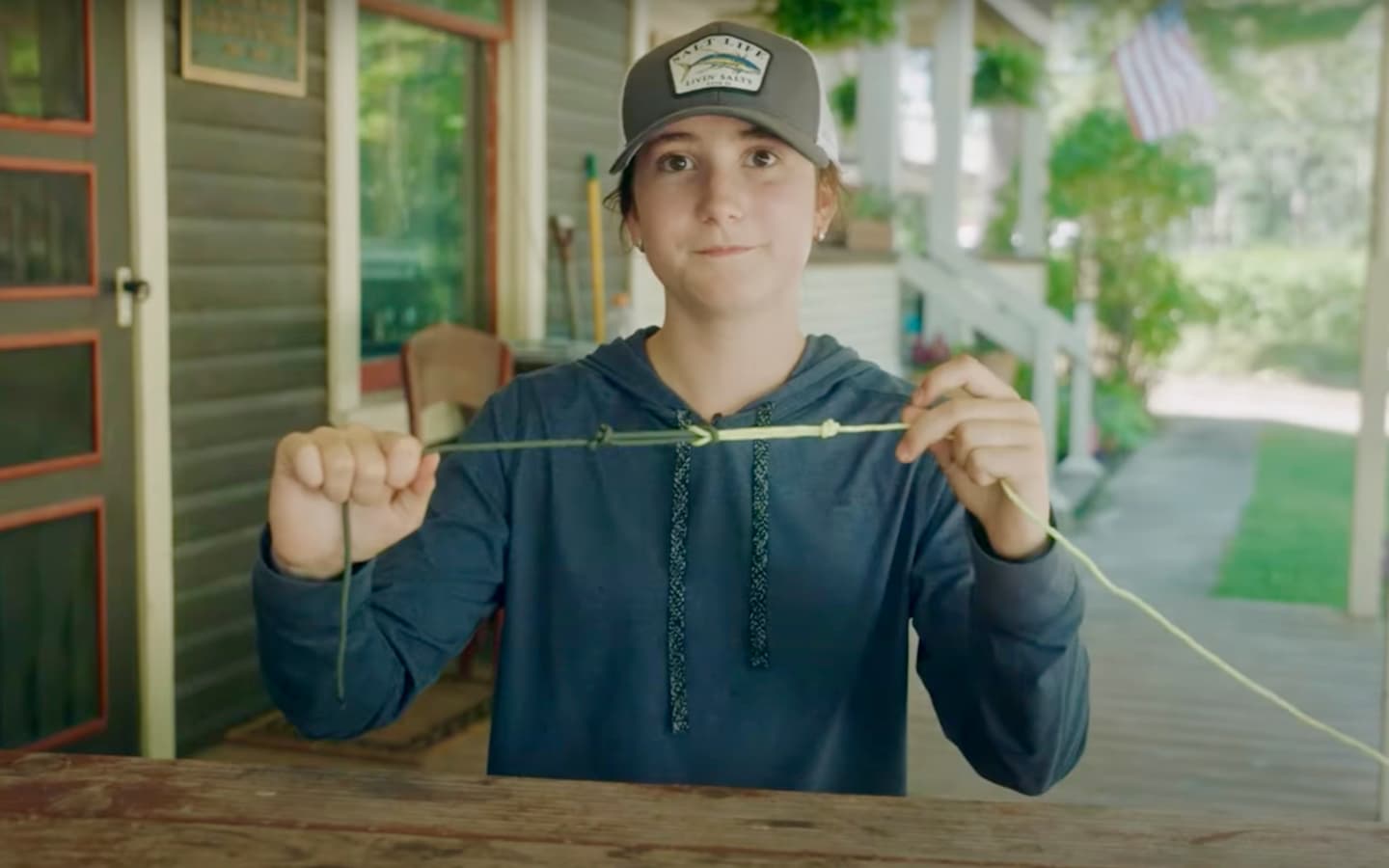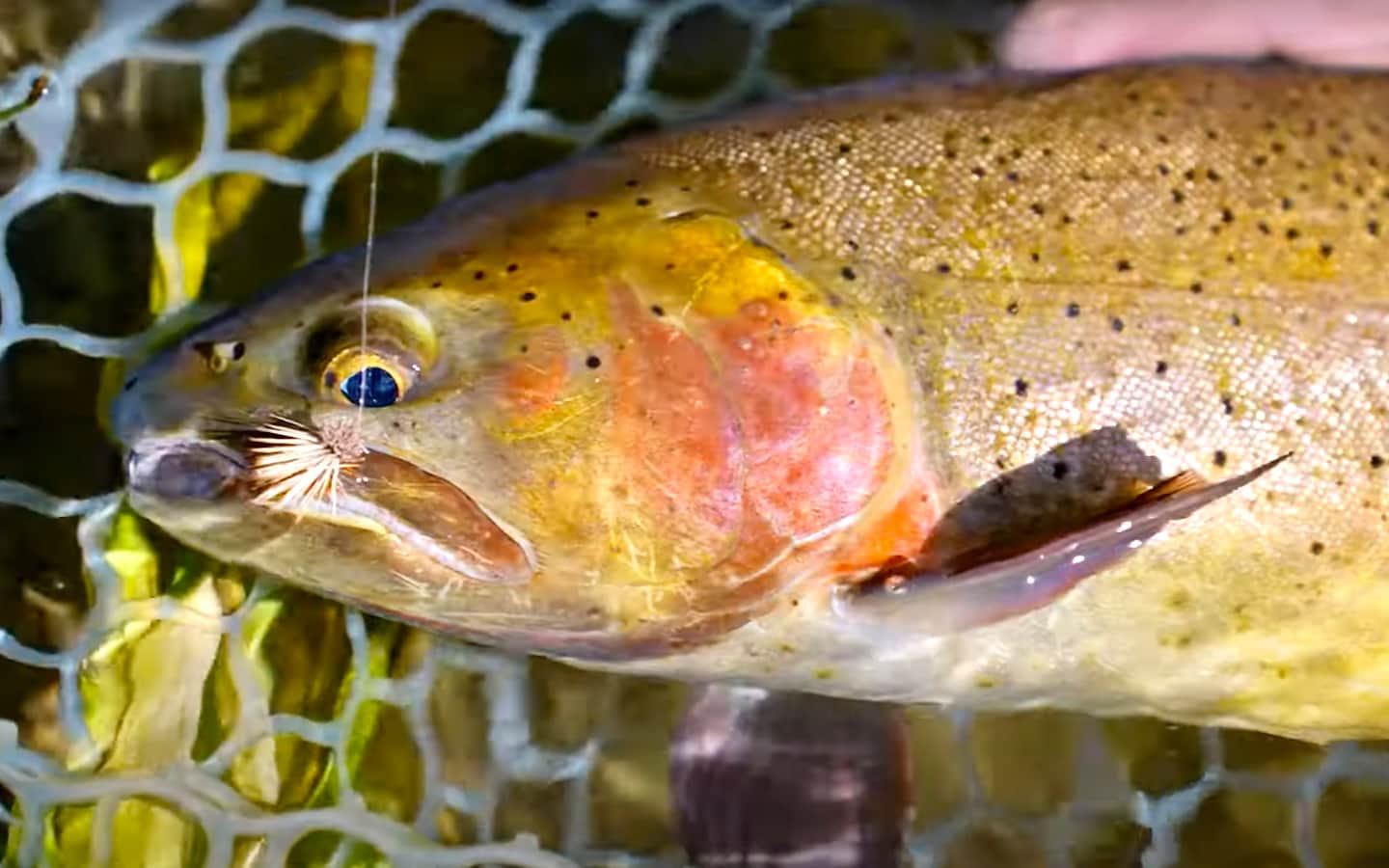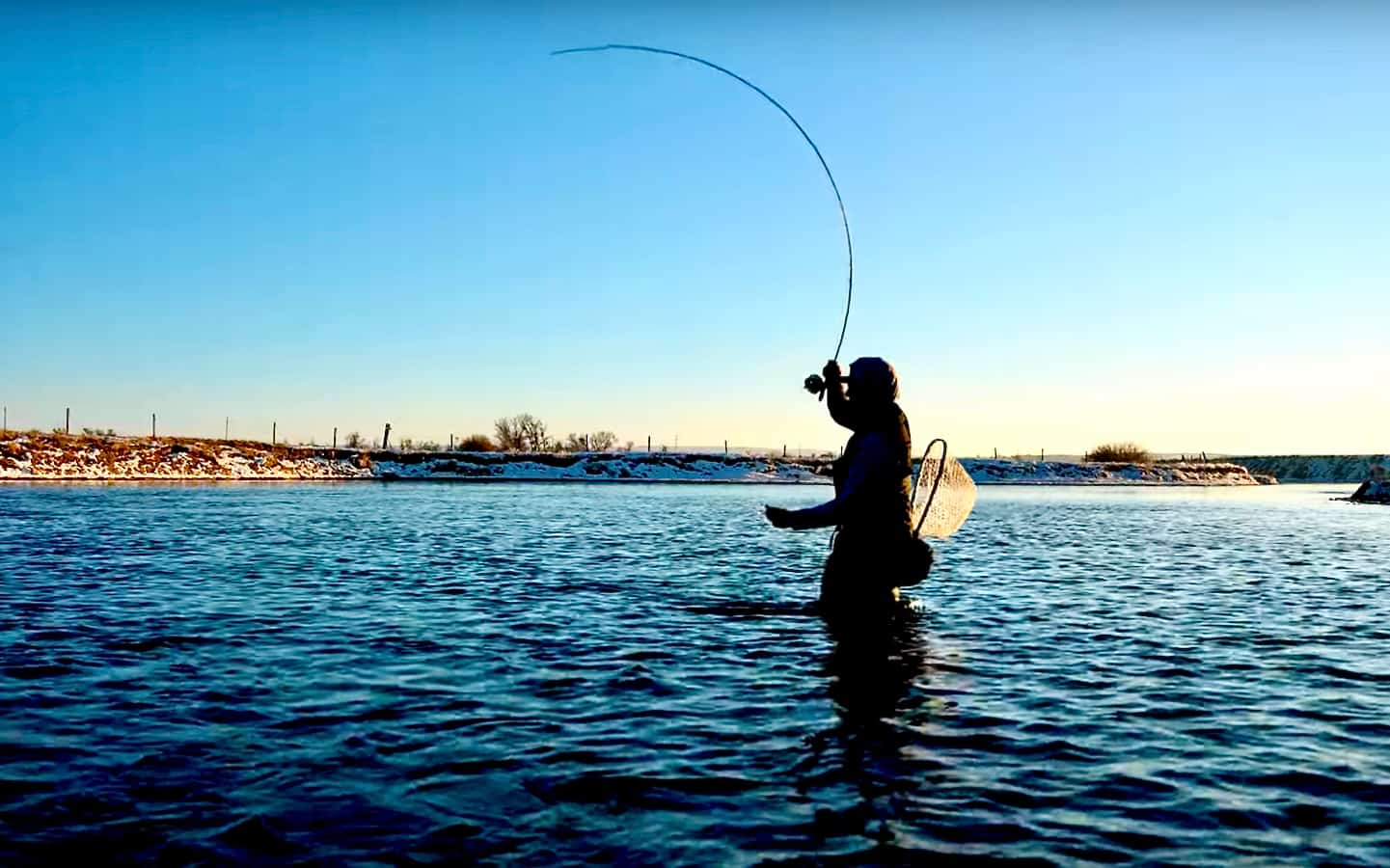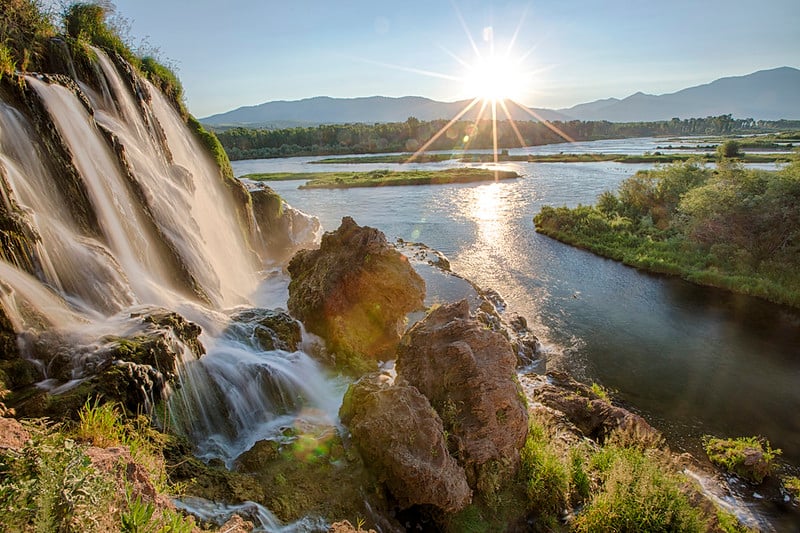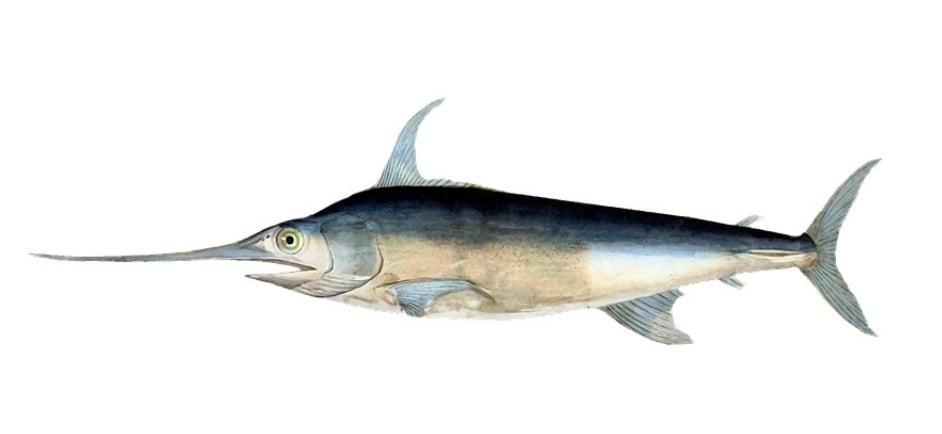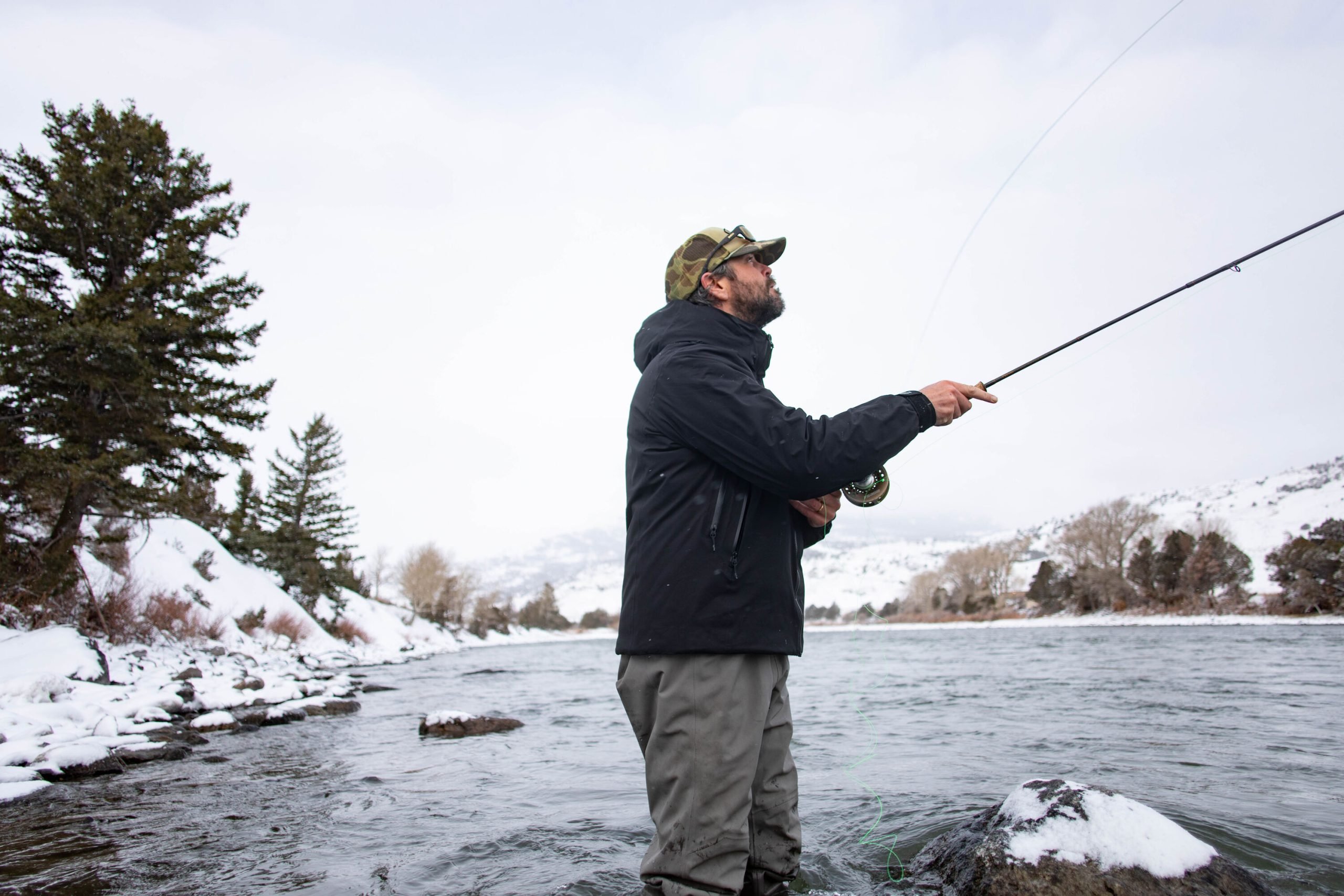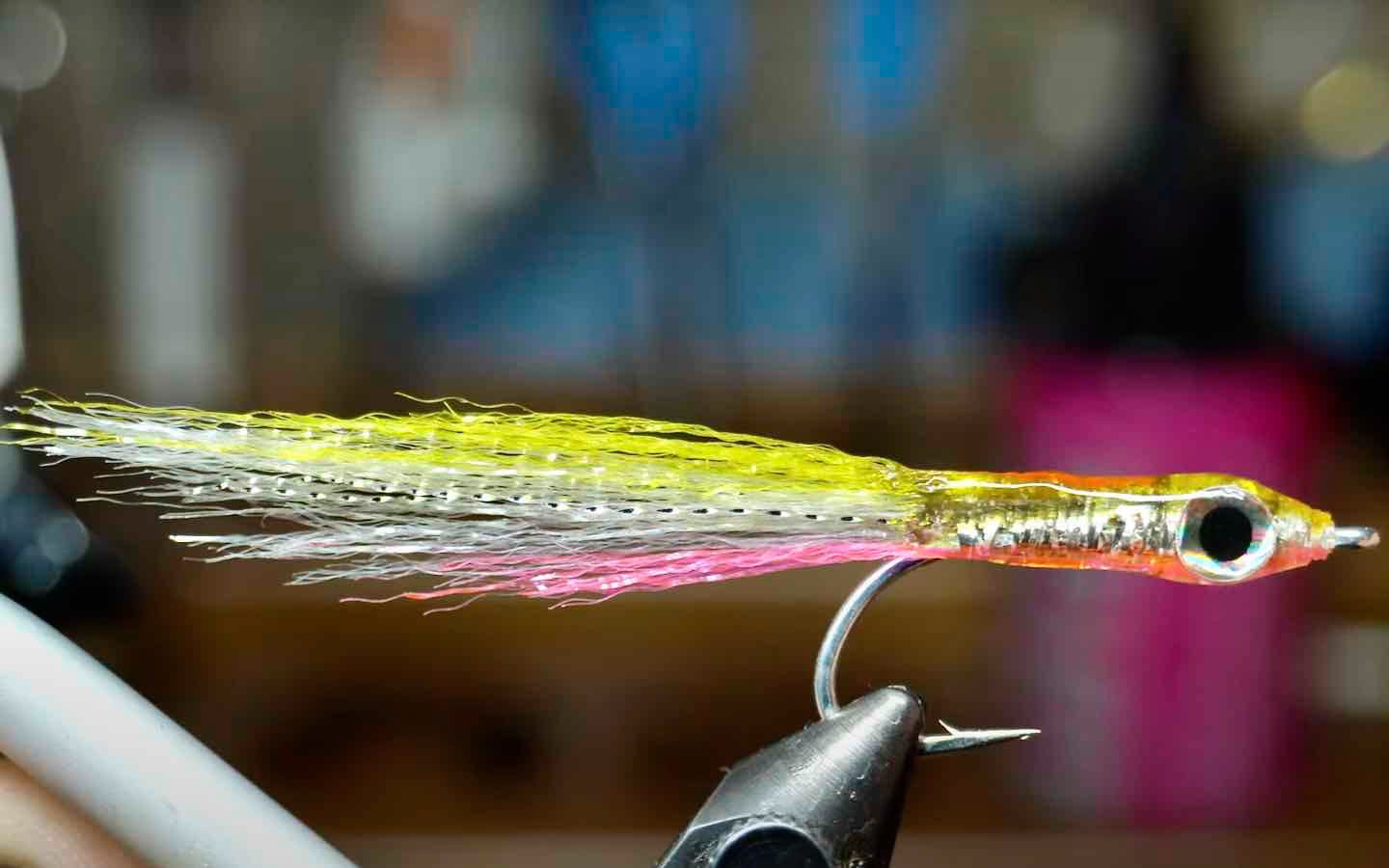Alaska Trips: Choosing a Lodge

Close up view of pink or "humpy" salmon spawning in Alaska.
THE TIME HAS COME. From the age of twelve, you’ve dreamt of it. The Great Land. Alaska. You’ve read and re-read every magazine article ever written about it, pored over brochures filled with photos of incredible vistas, giant grizzlies and monster trout. You’ve thrilled to savage strikes from the comfort of your Barcalounger, staring gape-mouthed as the celebrity host hooks an unending parade of impossibly fresh, wildly cartwheeling salmon.
At outdoor shows you spend hours drooling over every lodge’s promotional video, imagining yourself standing waist-deep in that crystal clear tundra stream. Your nights are filled with visions of hook-jawed Arctic Char, ablaze with autumn colors, sail-finned grayling delicately sipping tiny dries, and thick, leopard-spotted rainbows slashing mice patterns off the surface. You, my friend, are a goner. There’s no turning back now, no pretending you enjoy your local trout stream just as much “in it’s own way.” Your life will never be complete until you’ve experienced The Last Frontier.
Mentally, you’ve made the commitment. The vacation time is there, for once the taxman was kind to you, and your spouse thinks you deserve it. Your obsession is starting to take shape and, like your first kiss, makes you almost giddy with equal parts of lust and trepidation. Will it be as good as you’ve fantasized, or will actually getting what you’ve wanted for so long prove a disappointment? The outcome, I assure you, is in your hands. Alaska can either be a trip of a lifetime, or a complete disaster, and a great deal of the outcome will depend on the research you do beforehand. There are questions you’ll need to ask yourself, questions you’ll need to ask your lodge or outfitter, and then you’ll have to choose from an amazing array of options.
As a travel specialist, it’s my job to help people find the answers to all those questions, and choose the Alaska lodge that is best for them. Read on, and I’ll attempt to do the same for you.
Book Early
First, and foremost, choose the year you want to go. This may seem a bit obvious, but you should understand that the best lodges have incredibly high rates of re-booking clientele. Returning guests, given the standard first right of refusal for their particular week, often choose to go again every year at that same time. Consequently, at some operations, time slots are rarely made available to new anglers. Your best shot at acquiring high demand dates is to book your trip a year in advance. This gives you first shot at any openings that do arise, and the lodge owners an opportunity to try and fit you in with a little creative juggling.
Using an Outfitter
If you are a real do-it-yourselfer, not afraid of a daunting amount of research, arranging your own first Alaskan trip can be a rewarding challenge. If, like most people, you have too little time to accomplish too many jobs, I would suggest looking into the services of a qualified travel outfitter. A good outfitter knows the ropes. They know which questions to ask, and how to listen to the answers. Their experience and breadth of knowledge will save you untold hours of phone calls, e-mails and Internet surfing. Whether you want to catch large chrome-bright kings at tidewater, or spring-run steelhead, a good outfitter will be able to give you a short list of options. Typically, I’d hook as many big rainbows in a 100-yard stretch as I would in a week back home. And it was all mine, whenever I wanted it.
Strong working relationships with their lodges allow them to quickly and thoroughly canvass a wide variety of destinations for potential available dates, and give invaluable insights into each operation. They can tell you what the rooms are like, what the guide to angler ratio is, and if beer is included in the rate. They understand they are dealing with your vacation time, possibly the trip of a lifetime, and take that responsibility very seriously.
A good outfitter will also be a serious angler, and able to make specific tackle recommendations. They know itineraries, motels and restaurants, en route. They can take the mystery (and uneasiness) out of how much to tip. They know details you never even thought to consider and, if they don’t have an answer, they’ll get it. Perhaps most importantly, they are able to help match you to a destination that will fulfill your individual expectations. And the best part? They’re absolutely free!
Budget Constraints
If you are on a tight budget, it will to some extent decide the style of adventures you’ll need to choose from. A few lodges offer less than full week packages, at correspondingly lower prices. Your round trip travel expenses are fixed, of course, so you’ll need to decide if all the traveling is worth a two- to four-day stay. Some operations offer float trips, providing rafts, equipment, meals and guides for a weeklong drift down a wilderness river. Assuming you’re rowing down a lightly used stream, this is an unparalleled way to observe undisturbed wildlife, become part of the backcountry, and lose yourself in its magnificence. Only experienced outdoorsmen or self-sufficient adventurers should consider this option, though, as damp clothes, an absence of bathroom facilities and a limited approach to style of fishing are all part of the game.
An often overlooked, but wonderful, option are the discounts that some lodges offer on less popular weeks. It’s not uncommon to see lowered rates for early- to mid-June dates at operations that don’t have king salmon fisheries. On the upside, this is normally the absolute best time for rainbows on dry flies and surface-fished smolt imitations. Similarly, a few destinations will reduce rates for the short window of time (usually in July) when the fewest species of “glamour” fish are available. If catching obscene numbers of bright, fresh, six- to ten-pound sockeye salmon appeals to you, however, this may be the week for you.
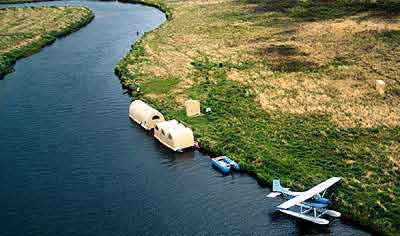
A good wilderness camp puts you right on top of the best water at the most affordable price. You will be comfortable, and close enough to the water to fish all day. photo courtesy of Dave Jones/Ayakulik Camp

A good wilderness camp puts you right on top of the best water at the most affordable price. You will be comfortable, and close enough to the water to fish all day. photo courtesy of Dave Jones/Ayakulik Camp
Wilderness Camps
Generally speaking, after a partial week, or a discount week, the next most affordable option is a week spent at a fixed base wilderness camp. At one time the mainstay of Alaskan operations, these camps are now a vanishing breed. The best are often located on remote reaches of rivers rarely accessed by other lodges. Truly sequestered from the outside world for a week, with no televisions, telephones, or blinking computers, can be an indescribably delicious experience. A good wilderness camp puts you right on top of the best water at the most affordable price. You will be comfortable, and close enough to the water to fish all day.
Using jet boats, you’ll cover seemingly endless miles of river, each day fishing water that sees only a handful of anglers annually. In the evening, after a hearty meal served in a woodstove-heated dining tent, you’ll trudge wearily to your Weatherport “cabin,” marveling at the clarity and immenseness of the cold night sky. Snuggling into the cozy warmth of a thick down bag, you’ll sleep like the dead until the guide wakes you in early morning light, a steaming mug of coffee ready to jump start you into another day in paradise.
Should you decide on a wilderness camp, understand that they usually place a higher emphasis on the angling than the creature comforts. Will you take a hot shower and sleep in a comfortable bed every night? Absolutely. Will the toilet flush and meals be served on fine china? Not likely.
Short on luxury, these camps are long on fishing. Normally, camp owners carefully choose their camps location, making sure they sit dead center in the region’s best fishing water.
In the unlikely event you don’t get enough during your guided day, the river always beckons just a long roll cast away. Recently I spent some time on such a camp in the Bristol Bay region. Every night after dinner, I’d shiver back into my damp waders, grab my still-rigged rod and follow the beargrass trail down to the “camp water.” The fishing was always incredible. Typically, I’d hook as many big rainbows in a 100-yard stretch as I would in a week back home. And it was all mine, whenever I wanted it. (All except that stretch right in front of camp, where five-pound rainbows make the water froth every night as bread scraps are deposited into the river. Sadly, the camp owner had declared these fish off-limits, and had the good sense not to let my sniveling and whining sway his decision.)
It is critical, when choosing a wilderness camp, that you know about the fishery. If you really want to go catch a bunch of rainbows, for example, and the camp is located on an estuarine salmon river, you’ll be disappointed. Ask the outfitter or lodge owner specific questions. What is the rainbow population like? Do the trout move in and out of the river, or are they there in good numbers all season? What significant salmon runs are in the fishery, and how do they effect the trout fishing? A good outfitter or operator will be excited that you are interested in such details, and more than happy to give you explicit answers. Remember, at wilderness camps, moving to another watershed is not generally an option. Make certain you understand the fishery, since you’ll be there for a week.
River Lodges
If a wood lodge and full amenities is more to your liking, the next jump in price will usually be to a river lodge. These operations will run the gamut from rustic to quite comfortable, with most falling somewhere in the middle. They will normally have full bath/shower facilities in each room and cabin, or a separate, shared building with these facilities. This is always a good question to ask, if it’s important to you. Some river lodges have both options. There will usually be a separate building that serves as the gathering/dining location. Here, anglers returning from a long day astream will gather, sharing lies in front of a crackling stone fireplace. Often, these permanent operations will have boardwalks and septic systems, luxuries the more temporary wilderness camps cannot always legally construct, due to stringent environmental regulations. In short, what you’re really paying for is improved creature comforts.
Like wilderness camps, river lodges are located on a particular watershed, and generally fish their anglers in exactly the same manner, using jet boats. Often, however, they have the option of hiring local air taxi services for their clients, sometimes on short notice. (Understand that flying time is expensive, so this alternative will not be included in the original package price.) For a fee, you can decide on any given evening to try a fly-out experience the next day. If several anglers want to go, the cost of the flight is split between them.
I remember staying at a top quality Iliamna region river lodge some years back, with a group of hard-core rainbow fanatics. The fishing had been fabulous, with everyone hooking dozens of fish each day. On our second to last night, the owner got off the radiophone and casually mentioned that a friend reported a huge push of silvers pouring into a particular small Kamishak Bay estuary. The noisy chatter in the room came to a dead stop. Suggestive eyebrow arches filled the air, and in short order a wad of cash was lying on the table. Early the next gray dawn, we stood huddled against the droning propwash of a pair of Beavers, piling in with all our gear. Watching the sunrise en route was worth the price of admission, as was the spectacular flight through coastal passes. Landing in the mouth of a tiny glacier river, we could see finning salmon everywhere. You can imagine the rest. Later, sitting around the fireplace at the lodge, each and every fisherman told me it had been the best hundred bucks they’d ever spent!
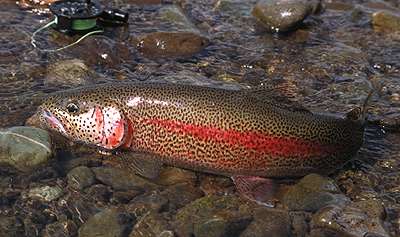
Alaskan rainbow.Photo courtesy of Mission Lodge

Alaskan rainbow.Photo courtesy of Mission Lodge
Fly-Out Lodges
The final category of accommodations are full fly-out lodges. Once thought of as luxurious options for the well-to-do, fly-out lodges now comprise the majority of backcountry fly-fishing operations. Generally speaking, they are the most expensive option, and provide their clientele with amenities that, considering their remoteness, border on opulence. Many have greatrooms that comfortably accommodate 12-24 guests, complete with leather furniture, impressive wildlife art and million dollar views. Private rooms or cabins are as nice as home, complete with full bath, reading areas — the works!
While almost every Alaska lodge will feed you well, the top lodges go above and beyond the call of duty. Double entrée’s have become more the rule than exception, and you’ll never see the same menu twice. I’ve eaten food that you couldn’t find at any but the nicest restaurants elsewhere, thanks to highly qualified chefs imported in for the short four-month season.
What you are really paying for at these top-notch lodges is flying time. It’s not cheap fueling and maintaining aircraft in wilderness Alaska, and these lodges normally own their own fleet. The advantage, of course, is being able to fish new water every day. Fisheries vary tremendously in Alaska. On any given day, you can choose between slinging heavy lines and oversized leeches to big river mega-bows, or quietly stalking small, ultra-clear creeks, sight-fishing for nervous two- to four-pounders. The next day you can opt for a 50-fish grayling adventure, all on dries, then switch gears, and throw gaudy streamers into short coastal streams for salmon so close to the ocean, they glow. For the really adventurous, fly a bit further for sheefish, northern pike and lake trout, or enjoy lunch served lakeside, inside an ancient volcano crater.
Some of my most memorable visuals have occurred, not streamside, but from the air. Memories flood back, like the time we emerged from an Alaskan snow squall and found ourselves directly above a beach full of at least two hundred walruses, braying and scattering in all directions; or holding my breath as we flew over immense stone escarpments, closing my eyes as the view vanished abruptly beneath the wings; and, just this year, following my pilot’s pointing finger down to a small clearing, where a pure white wolf intently tracked our progress. Yes, flying adds a whole other element beyond merely accessing the fish.
Despite nightmare stories of losing days of flying time to bad weather, the truth is most fly-out lodges lose less than two or three days in an entire season. Nevertheless, it’s always prudent to make sure any such destination has great “home water.” In the unlikely event you can’t fly, this will ensure you don’t lose any fishing time. Again, ask specific questions. What kind of fish will be present at the time I will be there? Are there enough jet boats for the whole lodge, if weather prohibits flying? These are all pertinent, important questions.
The Best Time of Year
After you’ve picked the type of accommodation that suits you best, the next question is, when do you want to go? The answer to this is integral with the species of fish you most desire: choose what you want to catch, and the “when” will follow.
King Salmon. The first major push of fish up into the southwestern Alaskan rivers is the mighty king salmon. They start to show in early June, with the run normally peaking around the end of the month. Many rivers enjoy excellent king fishing all the way through early July. King fishing with a fly is a serious endeavor, appropriate for the hard-core angler willing to sometimes spend long hours between hookups. The payoff is fish size — kings often average 20 to 40 pounds!
You’ll need an 8- to 10-weight rod, a reel capable of holding 200 yards of backing (if fishing in a large river, less in a smaller stream), and an assortment of fly lines spanning floaters through very fast sinkers. Most anglers should feel fortunate to average one to three hookups daily, though there are places where you could reasonably expect to double that, with good fishing skills. Expect excellent fish numbers, and crowds, at the lodges within a quick flight (20-30 minutes) of Anchorage. This is close enough for the locals to access, and they often do. Watersheds farther from Anchorage generally only see lodge anglers.
On many rivers, fishing for kings doesn’t offer a lot of other species options. Other salmon haven’t yet begun to ascend the rivers-rainbows, dollies, char and grayling, if present, are generally scattered. King anglers, like fanatical steelhead fishermen, plan their trips around catching fewer, but larger fish.
When fishing for kings, I prefer smaller streams, when possible. They concentrate the fish in reduced areas, where they’re easier to cover effectively with fly tackle. A 30-pound king on an 8-weight, tearing up a small pool, is truly something to behold — if you’re connected, it’s almost frightening! Remember your heavy tippet. Kings are generally anything but leader shy.
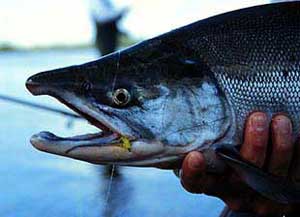
Sockeye salmon are bright and silver when they enter freshwater, but turn red upriver. Fresh sockeye can be tricky to take fairly — but they will attack a fly aggressively when they become more sexually mature.
Sockeye Salmon. The next big run of salmon are sockeyes, the most prolific run of all. Some rivers will see these ferocious battlers as early as late June, but most runs begin in earnest in early July. Not only do they enter Alaska’s wilderness waterways by the millions, they are also commonly believed to be, pound for pound, the strongest fighters of all the salmon species.
Averaging six to ten pounds, these are the original Energizer Bunny fish. Unlike most species, when tired they refuse to roll over and be unhooked. Countless rods have been shattered by their incredibly persistent fighting style, usually during the largely impossible stage of trying to land them. I’ll usually enjoy the initial reel-screaming, high-flying, line ripping acrobatics, then throw slack. I’ve been drenched, mud-showered, tail-slapped and otherwise physically abused too many times to actually want to land one of these guys.
Interestingly, despite these impressive qualifications, few serious fly anglers schedule their trip to coincide with the arrival of the “reds.” The reason primarily revolves around the controversial belief that, as filter feeders, they won’t actually take a fly. Though my experience doesn’t agree with this, the fact remains that they are often reticent eaters. The necessity of having to swing flies through immense, tightly packed pods, resulting in a high percentage of snagged fish, feeds this notion. I’ve been able to largely eliminate this problem by fishing small (#8-#10) flies and using floating lines and split shot to better control my drifts. I still “line” a small number, but find a majority will actually break from their school, track, and take my fly with an open mouth.
Happily, for the fisherman who wants to wear his arms out catching big fish, the sockeye run sometimes overlaps with both the king and chum salmon migrations. Many lodges take full advantage of this mid-summer phenomenon, wearing their anglers out with day after day of non-stop hookups. If this sounds appealing, go equipped with 7- and 8-weight rods (bring a spare), durable reels, a combination of floating and sink-tip lines and aspirin for those aching muscles!
Chum Salmon. Following the sockeyes in this anadromous parade comes the Rodney Dangerfield of the fish world, the chum salmon. They just don’t get any respect, and that’s a shame, because they deserve it. Chrome-bright and fresh from the sea, I’ll put this fish up against the much more popular silver salmon any day, for its eager willingness to suck in a fly and the sheer power of the ensuing battle. What they lack in an aerial arsenal, they more than make up for in brute strength and rod torturing tenacity.
I recently fished a small coastal river with a highly respected lodge owner/pilot/guide who has landed more big salmon in his decades in Alaska than most commercial netters. Giving him a couple of new, high-tech rods to sample, I watched, incredulous, as both were unceremoniously reduced to graphite rubble, courtesy of a pair of oversized chums. These fish are beasts!
Expect chum runs to be heaviest during July and August, depending on locale. They love big streamers in various shades of chartreuse, fuscia and purple, hammering them with consistently solid takes. Chums average 8 to 15 pounds, so a strong 7- or 8-weight rod is most appropriate, matched with a high quality reel holding 150 yards of backing. Sinking-tips are generally most useful, though chums will take big Pink Pollywogs off the surface just like a silver, so make sure and pack a floater.
Pink Salmon. On even-numbered years, Alaska experiences huge runs of pinks, or “humpies,” as the smallest of the salmon species is affectionately known. Odd-numbered years will see very few, or none. The pink run closely mirrors that of the chum salmon, with plenty of fish in most river systems by July. If your timing is right, and you choose the lodge carefully, it is sometimes possible to catch a “slam” of four species of bright salmon at this time, including kings, chums, sockeyes and humpies.
Pinks have been accurately described as “God’s gift to the angling challenged.” They are aggressive almost beyond belief! Due to their relatively small stature (averaging 3-6 pounds), they are often considered a nuisance while fishing for other, more glamorous species. The fact is, matched against a 4-or 5-weight rod, they’re a blast, and you’d be hard-pressed to find a fly they won’t eat. Time and again I’ve watched roving pods of hyper-competitive humpies race each other 10 or 20 feet for a poorly presented fly. For fun, try skating a small Pink Pollywog past a school of pinks — it’s like dropping a cat into the dog pound!
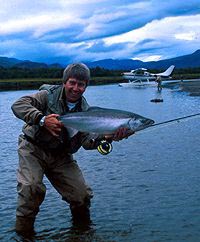
Coho salmon (silver salmon) will crush a surface pattern aggressively right at tidewater, and run and leap like a steelhead.
Silver salmon. The very name of this wonderful gamefish conjures up memories of fog-shrouded mornings at the edge of the world. Chrome shadows, perfection with fins, coursing in pairs up gravelly tundra rivers, just as they have for centuries. Heavy shouldered wakes erupt in impossibly huge, heart-stopping boils. The electrifying tighten in mid-strip, angry headshake, followed by sheer, awe-inspiring power, ripping the surface, filling the air with violent, tearing cartwheels. Are you ready?
Easily the most sought after salmon by the serious Alaska flyrodder, the coho has earned its reputation as a warrior. Averaging 8 to 10 pounds, with the occasional monster topping 20, these fish are about all a seasoned angler can handle on a 7- or 8-weight outfit. They are aggressive to a fly, but pleasantly fickle, not unlike steelhead — some days you have to work for them. More often, though, you’ll have to quit, arms aching with fatigue.
Silvers begin returning to their natal rivers by late July and early August. Depending on the watershed, either August or September may prove to be the peak run, with some southwestern rivers enjoying fresh fish well into October. Generally speaking, you’ll find them in long, gentle runs with lots of “soft ” water, or stacked in backwater sloughs and back eddies. While sinking-tips and bright streamers are standard fare, many silvers will attack a Pink Pollywog “chugged” across the water’s surface. You’ll never forget the first “Wog” grab you get, the big bow wake suddenly appearing behind your fly, tracking it briefly before the inevitable massive “toilet flush,” as the salmon inhales your bug. Nor will you forget the incredible, glowing, perfectly scaled translucence of the fish, fresh in from the sea. They truly are a magnificent species.
If silvers are a major target quarry for you, it pays to ask very specific questions about their availability. Will there be chrome-bright fish when you are there? What kind of hook-up numbers are normal during your week each year, given your honest angling abilities? Are the fish average-sized (6-10 pounds), or are there good numbers of larger fish (12-15 pounds)? What kind of water will you be fishing — backwater sloughs, long pool current seams, tidal water? Are there good Pollywog opportunities? Silvers vary significantly from one part of Alaska to another, so such questions are appropriate. Finally, don’t shortchange “upstream” fish that have begun to color. While admittedly not the crazed beasts ocean-fresh fish are, they are often even more aggressive to surface flies. Matched against a 6 or 7-weight outfit, they’re still a handful.
Rainbow Trout. You’ve heard the stories. Great, steelhead-like rainbows flooding autumn rivers. Huge, leopard-spotted trout deliberately sucking skated mice (that’s right, mice!) patterns from the surface. Dozens of crimson-barred beauties, each a trophy anywhere else, sprinkled liberally behind an endless procession of spawning salmon. The actual facts? It’s all true if you can get on the right water at the right time. Despite an increase in the numbers of people accessing Alaska’s remote wilderness trout rivers, the rainbow fishing remains an unparalleled experience, unduplicated anywhere in the world.
It’s important to understand the many faces of trout fishing in Alaska. Early season, June and early July, means dry fly and nymph fishing, fast-stripping smolt patterns, and bottom-bouncing meaty leech and sculpin flies.
The arrival of salmon into the watersheds dramatically changes things. First, salmon are big, and routinely displace all but the largest of rainbows from their normal lies. Then, as spawning begins, trout become transient, congregating in concentrated groups behind the salmon redds, gorging on drifting eggs. Small single egg patterns can be ridiculously effective at this point, usually encompassing all or parts of July, August, and September.
Rainbow trout are one of the most sought-after species in Alaska, but poor planning can dramatically reduce your chances of catching a trophy. Rely on the experience on an outfitter to put you on the right river at the right time.
Importantly, dead and decomposing salmon carcasses provide a final, major late season protein grab for the trout, which rip and tear at these moldy cadavers, picking them clean like so many hyenas at a water buffalo barbecue.
Many streams experience a late fall migration of mega-bows out of integral lake systems. These are the true brutes of the season, trout that can average six, eight, even ten pounds. Each year, a few lucky anglers in the Iliamna region land fish in excess of 15 pounds, trout the size of a large steelhead! This phenomenon normally begins in mid-September, and continues well on into October. For the serious trophy hunter, this is a magic time and place- short, cold days, low clear water and with every cast, the chance at a trout of a lifetime.
Tackle for Alaska rainbows is easy. A 9-foot, 6-weight rod, along with a sturdy reel equipped with a floating and a sinking-tip line, will handle anything you’ll encounter. This outfit also suffices nicely for the ancillary species often found coexisting with trout — dolly varden, char and grayling. Choose your flies carefully, based on when and where you’ll be going in Alaska.
Steelhead. In the last several years, significant steelhead runs have been “discovered” in Alaska. Generally speaking, they are separated into two seasons — spring and fall. The spring fishery is often a mix of fresh and spawning fish, while the fall run is all ocean-bright. So far, the majority of fish have been found in southwestern Alaska and the Aleutian Peninsula. A real bonus for the serious steelhead angler, these runs add a whole new frontier to the existing face of the sport.
The watersheds these steelies are found in are remote, and often require staying at rustic destinations. But considering that fish often average 10 to 12 pounds, with many up to 15, this is a small price to pay for the zealous angler. Expect cold weather, as prime months are April and October. Tackle requirements include 7- to 9-weight outfits, with floating and sinking-tip lines. Flies are standard steelhead fare, with big dark leeches and egg patterns the rule. Quality Alaskan steelhead operations are rare — expect availability to be very limited. Like all successful lodge operations, there are sometimes waiting lists to get into prime dates.

